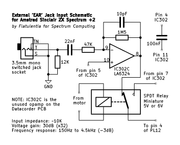This piqued my interest as I wanted to add an external 'EAR' socket to my +2 with the minimum of additional internal clutter and wiring. The schematic below is the solution I came up with.

(Schematic created in KiCad)
Note: The LA6324 quad opamp on the Datacorder PCB is designated as IC302 on the official schematic, so I've kept that designation for the sake of clarity.
The intent was to provide a filtered input with enough gain to load software from a typical smartphone's headphone output. It also works well with a vintage 'shoebox' cassette recorder I refurbished recently, and from the adjustable headphone output on my Teac hi-fi cassette deck.
The opamp and its associated components form a simple bandpass filter that attenuates signals below 150Hz and above 4.5kHz. This provides a degree of simple signal conditioning by reducing any mains hum, rumble and hiss that may be present on old data cassette recordings.
A suitable bias voltage for the opamp's non-inverting input is picked up from pin 5 of the LA6324 which already connects to a potential divider that provides a voltage of around 1.75V. This is the centre point of the maximum output voltage swing of 3.5V, so the amplifier clips symmetrically.
A DC path to ground is provided for the source amplifier via the 12K resistor. This also helps maintain the circuit's input impedance somewhere in the range of 9.5K to 12K across the entire audio spectrum, thus providing a relatively simple load for any source to drive.
As we don't want to add any more noise than necessary to the Spectrum's audio output signal when not loading, the input jack is of the switched type and wired to short the input of the amplifier to ground when no jack plug is inserted.
The relay switches between the original Datacorder output from pin 7 of the LA6324 and the output of our new input amplifier (pin 8) depending upon whether the Datacorder's motor is running. The motor doesn't run when the cassette mechanism is in STOP mode, so the new amplifier becomes our input source under this condition.
A 100nF capacitor is placed across the supply pins of the LA6324 to filter out any high frequency interference that may be present on the 5V rail.
And here are the main components in-situ. Excuse the mess, but this photo was taken during the prototyping phase.

The screened cable you can see at the bottom of the photo leads out to the 3.5mm mono switched jack socket mounted on the back of the upper case directly behind the Datacorder for easy access. Mounting the jack socket in the upper half of the case means that both case halves still separate as per usual for easy servicing.
If you've already carried out a relay mod to disconnect the noisy Datacorder signal when in STOP mode and the relay is a changeover type (ie, SPDT), you're already part way there in terms of implementing this mod.
Have fun!